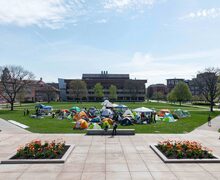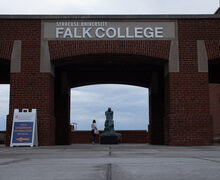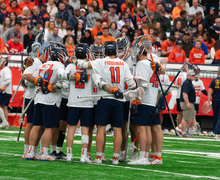Barillari: Social media discourages active rallying instead of bringing protesters together at SU
More than 800 individuals said they would attend the rally to protest the reassignment of Department of Public Safety Officer Joe Shanley last Monday via Facebook. Only about 45 individuals actually showed up.
Taking to the streets to stand up for what you believe in, consumed by the passion to make a difference in the world, is an exciting concept. With the ever-evolving networks of social media, causes can be publicized on a grand scale, therefore increasing awareness of their existence through Facebook pages and Twitter hashtags.
But, unfortunately, this greater sense of awareness is not creating a greater turnout at rallies, including protests at Syracuse University. Support for causes is fading following the “like” of protesters’ Facebook pages or a retweet of their call to action. The desire to rally is not spreading. It is instead stifled, trapped in the world of social media.
After the onset of the Arab Spring – in which activists used social media to distribute information and organize protests comprising thousands of people – many argued these rising communication technologies were integral to igniting modern revolutions.
But as more groups aim to use social media to orchestrate plans in a similar way, situations like the Arab Spring are seemingly becoming the exception, not the rule.
In a paper widely discussed after the onset of the Arab Spring, Navid Hassanpour, a doctoral candidate in Yale University’s political science department, argues social media “actually hurts a particular group’s chance of organizing a meaningful and successful revolution,” according to an August 2011 article on CNN.com.
In the paper, Hassanpour, who is studying conflict in relation to means of communication at Yale, writes: “Social media can act against grass roots mobilization.” He claims “they discourage face-to-face communication and mass presence in the streets,” according to the article. He says this in-the-flesh interaction is the key to political mobilization.
This theory may explain the demise of large-scale protests here at SU.
Before the rise of social media, this campus was the location of significant protests, including the 1970 student strike against the Vietnam War when crowds covered the Quad, and the 2000 protest against SU apparel being manufactured in sweatshops, which included demonstrations and petitions signed by more than 1,000 students.
On campus today, it seems we have relinquished our need to stand up for a cause. This is not because reasons worth fighting for no longer exist, but because we have decided clicking a mouse is the equivalent of taking to the streets.
We hide ourselves in the safety of our dorm rooms and apartments, claiming we support a cause and even suggesting we will attend the demonstrations. But when it comes to actually taking part in these calls to action, the need to come through on our social media-made promises falters. The rally for Shanley exposed this point.
Most rallies within the last year on campus have consisted of only a handful of students or community members. Last April, a small group protested former Secretary of State Hillary Clinton’s visit, and several individuals gathered in the ROTC lounge in September to protest the encroachment of the military on campus spaces. Students also assembled to speak out against the Dalai Lama’s October visit for his support of Tibet’s independence from China.
The Trayvon Martin rally in March was an increasingly rare circumstance with its attraction of more than 200 students.
One thousand “likes” on a Facebook page do not have the same sincerity of 1,000 people holding signs on the streets. Though large-scale rallies are not necessary for every cause, when they are needed to make a change, we should exercise our right to assemble.
If you are passionate about a cause, shut down your computer, grab your picket sign and take to the streets. It’s rally time.
Rachael Barillari is the editorial editor and a junior political science and Middle Eastern studies major. Her column appears weekly. She can be reached at [email protected] and followed on Twitter at @R_Barillari.
Published on February 4, 2013 at 2:30 am




